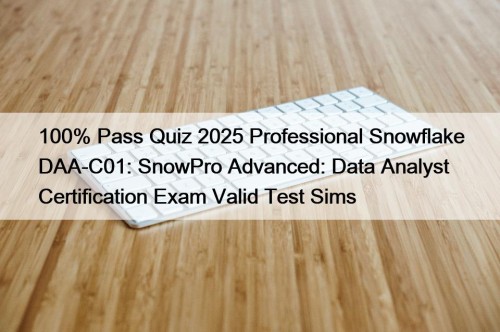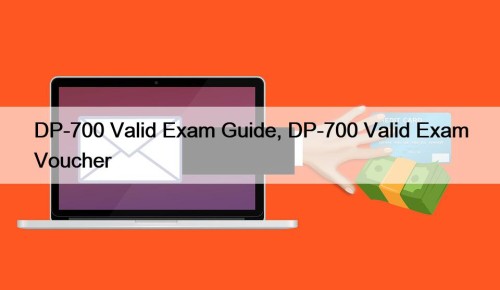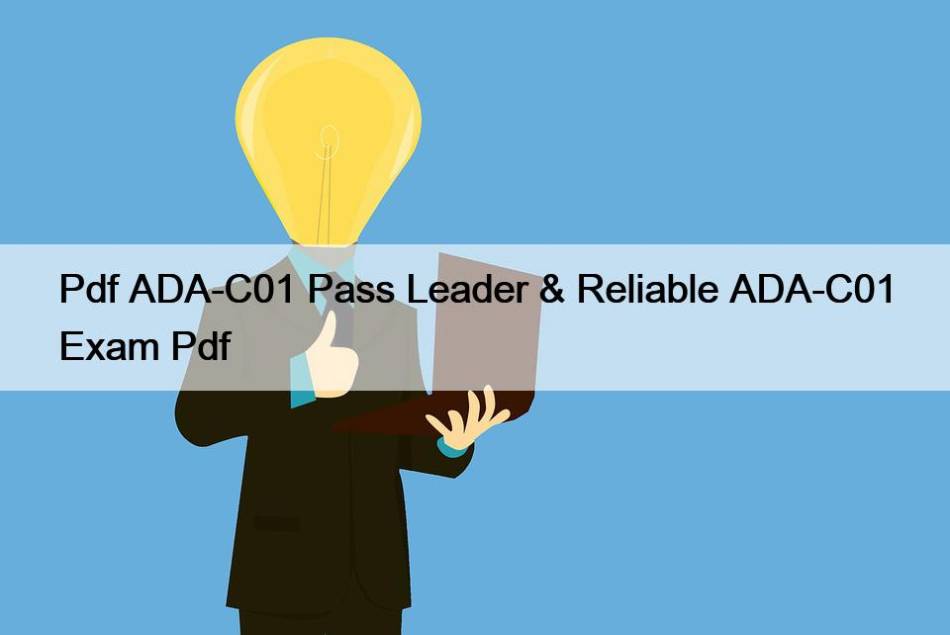Most Popular
 100% Pass Quiz 2025 Professional Snowflake DAA-C01: SnowPro Advanced: Data Analyst Certification Exam Valid Test Sims
100% Pass Quiz 2025 Professional Snowflake DAA-C01: SnowPro Advanced: Data Analyst Certification Exam Valid Test Sims
The APP online version of our DAA-C01 real exam boosts ...
 Exam DP-700 Objectives Pdf, Exam DP-700 Materials
Exam DP-700 Objectives Pdf, Exam DP-700 Materials
We provide our candidates with valid DP-700 vce dumps and ...
 DP-700 Valid Exam Guide, DP-700 Valid Exam Voucher
DP-700 Valid Exam Guide, DP-700 Valid Exam Voucher
BTW, DOWNLOAD part of ITCertMagic DP-700 dumps from Cloud Storage: ...



Pdf ADA-C01 Pass Leader & Reliable ADA-C01 Exam Pdf

P.S. Free & New ADA-C01 dumps are available on Google Drive shared by PassReview: https://drive.google.com/open?id=1GnswCRNxA1aol3wtOIjIJG0MtEoDKCnM
The excellent Snowflake ADA-C01 practice exam from PassReview can help you realize your goal of passing the Snowflake ADA-C01 certification exam on your very first attempt. Most people find it difficult to find excellent Snowflake ADA-C01 Exam Dumps that can help them prepare for the actual SnowPro Advanced Administrator ADA-C01 exam.
If you have the certification the exam, you can enter a better company, and your salary will also be doubled. ADA-C01 training materials can help you pass the exam and obtain corresponding certification successfully. ADA-C01 exam materials are edited by experienced experts, and they possess the professional knowledge for the exam, and you can use it with ease. We have online and offline chat service, they possess the professional knowledge for the exam, and you can consult them any questions that bothers you. We offer you free update for one year for ADA-C01 Exam Dumps, and our system will send the latest version to you automatically.
Best Accurate Pdf ADA-C01 Pass Leader by PassReview
You can use this Snowflake ADA-C01 version on any operating system, and this software is accessible through any browser like Opera, Safari, Chrome, Firefox, and IE. You can easily assess yourself with the help of our ADA-C01 practice software, as it records all your previous results for future use.
Snowflake ADA-C01 Exam Syllabus Topics:
| Topic | Details |
|---|---|
| Topic 1 |
|
| Topic 2 |
|
| Topic 3 |
|
| Topic 4 |
|
| Topic 5 |
|
| Topic 6 |
|
Snowflake SnowPro Advanced Administrator Sample Questions (Q21-Q26):
NEW QUESTION # 21
A Snowflake organization MYORG consists of two Snowflake accounts:
The ACCOUNT1 has a database PROD_DB and the ORGADMIN role enabled.
Management wants to have the PROD_DB database replicated to ACCOUNT2.
Are there any necessary configuration steps in ACCOUNT1 before the database replication can be configured and initiated in ACCOUNT2?
- A. It is not possible to replicate a database from an Enterprise edition Snowflake account to a Standard edition Snowflake account.
- B. No configuration steps are necessary in ACCOUNT1. Replicating databases across accounts within the same Snowflake organization is enabled by default.
- C. USE ROLE ORGADMIN;
SELECT SYSTEMSGLOBAL ACCOUNT SET_PARAMETER ( 'MYORG. ACCOUNT1',
'ENABLE_ACCOUNT_DATABASE_REPLICATION', 'TRUE');
USE ROLE ACCOUNTADMIN;
ALTER DATABASE PROD_DB ENABLE REPLICATION TO ACCOUNTS MYORG. ACCOUNT2
IGNORE EDITION CHECK; - D. USE ROLE ORGADMIN;
SELECT SYSTEMSGLOBAL_ACCOUNT_SET_PARAMETER ('MYORG. ACCOUNT1',
'ENABLE_ACCOUNT_DATABASE_REPLICATION', 'TRUE');
SELECT SYSTEMSGLOBAL_ACCOUNT_SET_PARAMETER ('MYORG. ACCOUNT2',
'ENABLE_ACCOUNT_DATABASE_REPLICATION', 'TRUE');
USE ROLE ACCOUNTADMIN;
ALTER DATABASE PROD DB ENABLE REPLICATION TO ACCOUNTS MYORG. ACCOUNT2;
Answer: C
Explanation:
Explanation
According to the Snowflake documentation1, database replication across accounts within the same organization requires the following steps:
*Link the accounts in the organization using the ORGADMIN role.
*Enable account database replication for both the source and target accounts using the SYSTEM$GLOBAL_ACCOUNT_SET_PARAMETER function.
*Promote a local database to serve as the primary database and enable replication to the target accounts using the ALTER DATABASE ... ENABLE REPLICATION TO ACCOUNTS command.
*Create a secondary database in the target account using the CREATE DATABASE ... FROM SHARE command.
*Refresh the secondary database periodically using the ALTER DATABASE ... REFRESH command.
Option A is incorrect because it does not include the step of creating a secondary database in the target account. Option C is incorrect because replicating databases across accounts within the same organization is not enabled by default, but requires enabling account database replication for both the source and target accounts. Option D is incorrect because it is possible to replicate a database from an Enterprise edition Snowflake account to a Standard edition Snowflake account, as long as the IGNORE EDITION CHECK option is used in the ALTER DATABASE ... ENABLE REPLICATION TO ACCOUNTS command2.
Option B is correct because it includes all the necessary configuration steps in ACCOUNT1, except for creating a secondary database in ACCOUNT2, which can be done after the replication is enabled.
NEW QUESTION # 22
What session parameter can be used to test the integrity of secure views based on the account that is accessing that view?
- A. PRODUCER_TEST_ACCT
- B. SIMULATED_DATA_SHARING_CONSUMER
- C. MIMIC_CONSUMER_ACCOUNT
- D. TEST_ACCOUNT_ID
Answer: B
Explanation:
The SIMULATED_DATA_SHARING_CONSUMER session parameter allows a data provider to test the integrity of secure views based on the account that is accessing that view2. By setting this parameter to the name of the consumer account, the data provider can query the secure view and see the results that a user in the consumer account will see2. This helps to ensure that sensitive data in a shared database is not exposed to unauthorized users1. The other options are not valid session parameters in Snowflake3
NEW QUESTION # 23
What access control policy will be put into place when future grants are assigned to both database and schema objects?
- A. Database privileges will take precedence over schema privileges.
- B. Schema privileges will take precedence over database privileges.
- C. An access policy combining both the database object and the schema object will be used, with the most permissive policy taking precedence.
- D. An access policy combining both the database object and the schema object will be used, with the most restrictive policy taking precedence.
Answer: B
Explanation:
When future grants are defined on the same object type for a database and a schema in the same database, the schema-level grants take precedence over the database level grants, and the database level grants are ignored4. This behavior applies to privileges on future objects granted to one role or different roles4. Future grants allow defining an initial set of privileges to grant on new (i.e. future) objects of a certain type in a database or a schema3. As soon as the new objects are created inside the database or schema, the predefined set of privileges are assigned to the object automatically without any manual intervention3.
NEW QUESTION # 24
How should an Administrator configure a Snowflake account to use AWS PrivateLink?
- A. Use SnowCD to evaluate the network connection.
- B. Block public access to Snowflake.
- C. Contact Snowflake Support.
- D. Create CNAME records in the DNS.
Answer: C
Explanation:
Explanation
To configure a Snowflake account to use AWS PrivateLink, the Administrator needs to create CNAME records in the DNS that point to the private endpoints provided by Snowflake. This allows the clients to connect to Snowflake using the same URL as before, but with private connectivity. According to the Snowflake documentation, "After you have created the VPC endpoints, Snowflake provides you with a list of private endpoints for your account. You must create CNAME records in your DNS that point to these private endpoints. The CNAME records must use the same hostnames as the original Snowflake URLs for your account." The other options are either incorrect or not sufficient to configure AWS PrivateLink. Option B is not necessary, as the Administrator can enable AWS PrivateLink using the SYSTEM$AUTHORIZE_PRIVATELINK function1. Option C is not recommended, as it may prevent some data traffic from reaching Snowflake, such as large result sets stored on AWS S32. Option D is not related to AWS PrivateLink, but to Snowflake Connectivity Diagnostic (SnowCD), which is a tool for diagnosing network issues between clients and Snowflake3.
NEW QUESTION # 25
Which function is the role SECURITYADMIN responsible for that is not granted to role USERADMIN?
- A. Create new users
- B. Reset a Snowflake user's password
- C. Manage system grants
- D. Create new roles
Answer: C
Explanation:
According to the Snowflake documentation1, the SECURITYADMIN role is responsible for managing all grants on objects in the account, including system grants. The USERADMIN role can only create and manage users and roles, but not grant privileges on other objects. Therefore, the function that is unique to the SECURITYADMIN role is to manage system grants. Option A is incorrect because both roles can reset a user's password. Option C is incorrect because both roles can create new users. Option D is incorrect because both roles can create new roles.
NEW QUESTION # 26
......
Time is flying and the exam date is coming along, which is sort of intimidating considering your status of review process. The more efficient the materials you get, the higher standard you will be among competitors. So, high quality and high accuracy rate ADA-C01 practice materials are your ideal choice this time. By adding all important points into ADA-C01 practice materials with attached services supporting your access of the newest and trendiest knowledge, our ADA-C01 practice materials are quite suitable for you right now.
Reliable ADA-C01 Exam Pdf: https://www.passreview.com/ADA-C01_exam-braindumps.html
- Pdf ADA-C01 Pass Leader - Free PDF Quiz Snowflake Realistic Reliable SnowPro Advanced Administrator Exam Pdf 🦼 Open ☀ www.dumps4pdf.com ️☀️ enter { ADA-C01 } and obtain a free download 📤ADA-C01 Reliable Dumps Questions
- Quiz 2025 Snowflake ADA-C01: SnowPro Advanced Administrator Marvelous Pdf Pass Leader 🐷 Search for ➤ ADA-C01 ⮘ on ▛ www.pdfvce.com ▟ immediately to obtain a free download 🐣ADA-C01 Online Training
- Here's the Easiest and Quick Way to Pass Snowflake ADA-C01 Exam 📝 Go to website { www.examcollectionpass.com } open and search for ⏩ ADA-C01 ⏪ to download for free 🔎Exam ADA-C01 Collection Pdf
- 100% Pass The Best Snowflake - Pdf ADA-C01 Pass Leader 🐭 Enter ( www.pdfvce.com ) and search for ✔ ADA-C01 ️✔️ to download for free 🍌Exam ADA-C01 Collection Pdf
- New ADA-C01 Test Duration 🍽 ADA-C01 Reliable Test Forum 🧰 Exam ADA-C01 Sample 🧀 Download ▛ ADA-C01 ▟ for free by simply searching on ▷ www.pdfdumps.com ◁ 🐻ADA-C01 Online Training
- ADA-C01 Exam Preview 🎭 ADA-C01 Exam Preview 🥻 ADA-C01 Exam 🍶 Go to website ➡ www.pdfvce.com ️⬅️ open and search for ➥ ADA-C01 🡄 to download for free ☸ADA-C01 Reliable Dumps Questions
- ADA-C01 Online Training ✅ New ADA-C01 Test Duration 🤝 ADA-C01 Online Training 🔥 Immediately open ➽ www.exam4pdf.com 🢪 and search for ( ADA-C01 ) to obtain a free download 🔙ADA-C01 Discount
- New ADA-C01 Test Voucher 🥇 Simulations ADA-C01 Pdf 👖 ADA-C01 Exam 🍔 ⮆ www.pdfvce.com ⮄ is best website to obtain ⇛ ADA-C01 ⇚ for free download 🥏ADA-C01 Online Training
- Exam ADA-C01 Collection Pdf 🏢 ADA-C01 Online Training 🔉 ADA-C01 Learning Mode 🚖 The page for free download of ⇛ ADA-C01 ⇚ on ⏩ www.prep4pass.com ⏪ will open immediately 🏸Simulations ADA-C01 Pdf
- ADA-C01 Free Test Questions 🎦 Exam ADA-C01 Collection Pdf 🧤 ADA-C01 Reliable Test Forum 🥅 Enter ▛ www.pdfvce.com ▟ and search for ✔ ADA-C01 ️✔️ to download for free ⬆ADA-C01 Exam
- Pdf ADA-C01 Pass Leader - Free PDF Quiz Snowflake Realistic Reliable SnowPro Advanced Administrator Exam Pdf 🐊 Easily obtain free download of [ ADA-C01 ] by searching on ➽ www.passcollection.com 🢪 🤭ADA-C01 Exam Preview
- ADA-C01 Exam Questions
- aitechacademy.in freelancertuition.com mon-bac.com rickwal840.glifeblog.com picassoacademie.com quranerpathshala.com creativesindigenous.nativemax.com teachmetcd.com improve.cl classink.org
What's more, part of that PassReview ADA-C01 dumps now are free: https://drive.google.com/open?id=1GnswCRNxA1aol3wtOIjIJG0MtEoDKCnM
Tags: Pdf ADA-C01 Pass Leader, Reliable ADA-C01 Exam Pdf, Sample ADA-C01 Questions Pdf, Certification ADA-C01 Exam Dumps, Test Certification ADA-C01 Cost